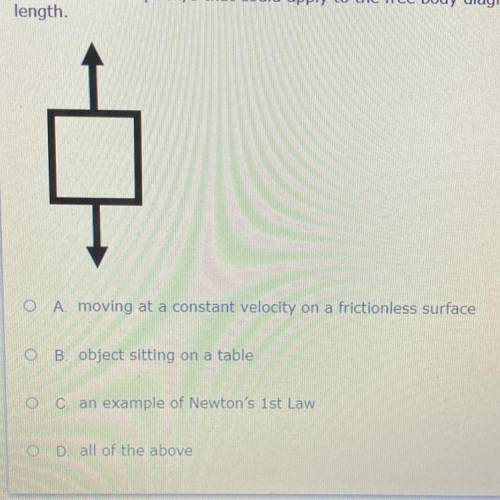
Physics, 06.11.2020 02:50, joshuaburton773
What could apply to the free body diagram in the image, assuming the force vectora shown are of equal lenght.


Answers: 2
Other questions on the subject: Physics

Physics, 22.06.2019 12:00, connorhanratty6487
In an experiment, how can i change human errors? be specific.
Answers: 1


Physics, 23.06.2019 00:00, jazminemendezhidalgo
If water vapor with the mass of 35.0 grams is cooled and condensed into water in a closed system such as a closed glass jar, what is the mass of the water after the water vapor completely condenses? a) 34.5 grams b) 35.0 grams c) 35.5 grams d) the mass cannot be determined without knowing the volume
Answers: 2

Physics, 23.06.2019 03:20, marshaehayes9444
Neutrons are placed in a magnetic field with magnitude 2.30 t. part a part complete what is the energy difference between the states with the nuclear spin angular momentum components parallel and antiparallel to the field? δe δ e = 2.77×10−7 ev previous answers correct part b part complete which state is lower in energy: the one with its spin component parallel to the field or the one with its spin component antiparallel to the field? which state is lower in energy: the one with its spin component parallel to the field or the one with its spin component antiparallel to the field? parallel antiparallel previous answers correct part c part complete how do your results compare with the energy states for a proton in the same field (δe=4.05×10−7ev)? how do your results compare with the energy states for a proton in the same field this result is smaller than but comparable to that found in the example for protons. this result is greater than but comparable to that found in the example for protons. previous answers correct part d the neutrons can make transitions from one of these states to the other by emitting or absorbing a photon with energy equal to the energy difference of the two states. find the frequency of such a photon. f f = mhz previous answersrequest answer incorrect; try again; 5 attempts remaining
Answers: 2
Do you know the correct answer?
What could apply to the free body diagram in the image, assuming the force vectora shown are of equa...
Questions in other subjects:

Mathematics, 03.03.2021 19:30





Mathematics, 03.03.2021 19:30

History, 03.03.2021 19:30


English, 03.03.2021 19:30






